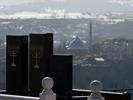With 27,000 people, Quba is the main town of northern Azerbaijan. It serves as a trade center for people living in the mountains near there and hosts some tourists from Baku on weekends. Its only distinguishing feature is the post-Soviet-era Bet Knesset Synagogue, a sign that this town is the center of Azerbaijan’s small Jewish population. Famous for carpets and apple orchards, the low-key town of Quba (the Q sounds like a G) sits on a cliff top overlooking the Qudiyalchay River. It was founded in the 18th century as the new capital of local potentate Fatali Khan but rapidly became a quiet provincial backwater once the khanate had been absorbed into the Russian Empire (1806). A fair scattering of modestly historic buildings remain from that period and today Quba's wooded hinterland is becoming a popular spot for Baku weekenders, thanks to its distant horizon of snow-topped mountains and a comparatively cool summer climate.
Sights - Quba is quite well preserved and still bears a lot of architectural marks left by the Russians. Besides numerous interesting facades, the town is famous for such architectural landmarks of the 19-th century, as the octagonal Juma-Mosque (Friday mosque), the Mosque of Sakine-Khanum, the Ardabil-Mosque (formerly a church!), and the baths with their two domes.
There's a little History Museum but the main attraction in Quba is just wandering its orderly grid of quiet leafy streets and admiring the 19th-century Russian houses and distinctive mosques, notably the colourful Haci Cafar Mosque and the unique, octagonal Juma Mosque with its distinctively pointy metallic dome. Notice also the decrepit century-old Gunbazli hammam with its big beehive dome.
Nizami Park is a pleasant tree-shaded retreat overlooking the broad gravel bed of the Kudiyalchay River.
One thing of interest, though, is the Jewish settlement of Krasnaya Sloboda. A long flight of steps lined with statues of Adonis-like Soviet youth leads down to the old bridge, which links Quba to the town of Krasnaya Sloboda, home to a unique Jewish community with two active synagogues. It's on the northern bank of the gorge of the Kudyal river, just facing it's sibling city, Quba. This Jewish settlement of Quba has been inhabited by Jews since the 13th century. In 1742, a local ruler named Falikhan gave the Jews, who were being persecuted by Islamic fundamentalists, permission to settle on the left bank of the mountain river Kudiyal-Chay opposite his town. It's strange to walk around the village and have locals say the Hebrew "Shalom" instead of "Salaam". Everywhere there are the Star of David, and even a couple of working Synagogues. You can hike up to the Jewish cemetery on the hill over looking the twin cities and watched the marvelous panorama.
You can watch Quba's famous carpets being made at Qadim Quba, which also has a delightful boutique selling them along with handicrafts and paxlava (alternating layers of chopped nuts and white, stringy, fried pastry, all saturated in a sickly sweet syrup).
Life here is slow. Chatting around a table, drinking tea is the main activity, like most small villages in the area. The people are generally friendly.
The 165 km trip from Baku will take you about 3,5 hours. The road leading there, hugs the seaside for the majority of the journey, but the scenery is less than spectacular.
If you're planning a trip to Azerbaijan you may be interested ▶ Azerbaijan highlights - For those who prefer to go unbeaten path, to explore less visited places and check national charisma of this small country in Southern Caucasus on the edge of Europe.











